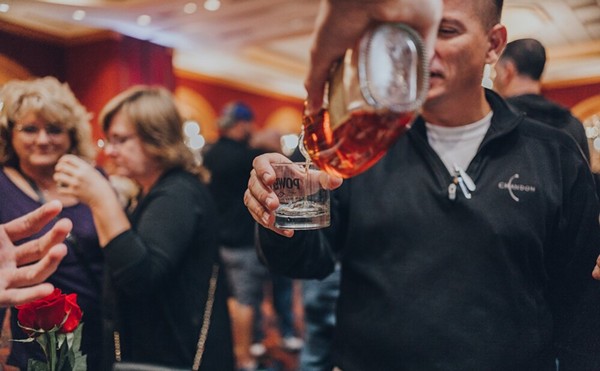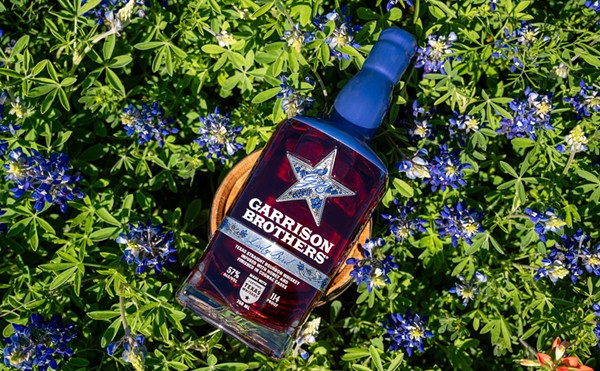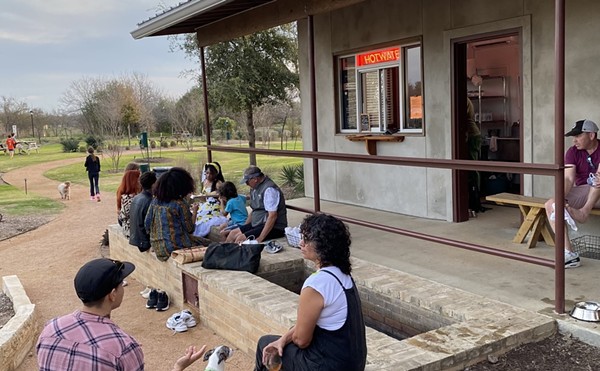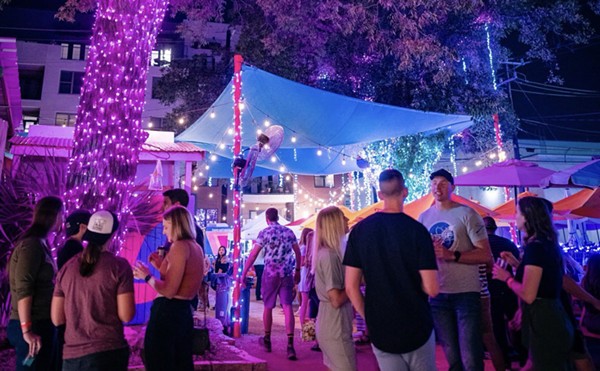“Not long ago” is a key phrase, however. Whereas Anderson felt obliged to say in 1982 that “Campanian viticulture has never fully recovered from a decline that began with the fall of the Roman Empire,” today the picture is beginning to change. Kamikazi consultants, and dedicated winemakers such as Mastroberardino, have taken indigenous varietals (and a few carpetbaggers such as cabernet sauvignon), reduced their yields, and crafted wines of great interest and, reputedly, of great power and intensity. What else would you expect from a wine made from grapes called negroamaro? The Omniboire tasting panel picked up the gauntlet where Anderson flung it and found that, far from being black and bitter, some of the new wines of the Italian south were almost blithe and bonny. Almost.
This month’s tasting was hosted by Joe Buonincontri, as of the day before the sole owner of Luciano at the Strand. (Look for a name change in the near future.) The wines were selected by the staff at Saglimbeni Fine Wines (and all are available there) and presented by Saglimbeni staffer Laura Atkinson, author of much of the wine material in the store’s online newsletter and future candidate for the Master Sommelier designation. Other tasters included Dave Zinni , Central Texas Regional Manager for WineRight wine brokers and himself on the track of a future Master of Wine diploma; Gary Darling, a telecommunications engineer with a substantial home cellar (despite the fact he admits of only one bottle of zinfandel); Luciano staffer Jose A. Garcia (non-voting but not non-vocal); and yours truly. No one was shy about opinions.
Opinions don’t fully develop until the end of the tasting when bottles are unmasked, but despite conflicting feelings about many of the eight wines, only one, from Calabria, got the boot by unanimous accord. That it was also the lowest-priced wine didn’t establish a price-quality trend, however; the second-cheapest wine was also the second-highest-scoring. “I don’t like wordplay on wine labels,” groused Darling, who nevertheless thought it had a much longer finish than expected. And the tongue-in-wherever Fourplay, blended from four Sicilian grapes we’ve never heard of, was clearly designed to appeal to a cute-label market.
But “it’s got guts and nerve,” countered Zinni, who felt it had started out French on the palate, only to become more Italian.
“It’s also got character and charm … You don’t have to think about it too much,” offered Atkinson.
Like most of the wines tasted, Fourplay bore an IGT designation, standing for Indicazione Geografica Tipica, a signifier meaning the wine is typical of its geographic region — a step up from table wine, but also often the category in which some of the renegade Super Tuscan wines fall. (The stricter norms are DOC, the equivalent of France’s AOC, and DOCG, which adds garantita — guaranteed — to controlled-origin status.)
Finding “crème brûlée and sweet vanilla” in the other Sicilian wine, the Enzo di Sette Rue nero d’avola, Darling claimed “with the right food, I’d jump right on it.” “Powdered-sugar donuts” seconded Atkinson, but Zinni found it had “no zing,” and we all felt the label recommendation to pair it with big meats was over-reaching.
Two Puglian wines from the heel of the boot received nearly identical scores — but for completely different grapes. “I hated it,” said Darling of the Antica Masseria Sigilo Primo, made from primitivo, the Italian equivalent of America’s zinfandel. (This is the guy with one zin in his cellar, remember.) But Zinni thought it had a “voluptuary feel,” and all noted that the bottle instructions to open an hour ahead of time were correct; it improved greatly on re-tasting.
Negroamaro was the foundation of our only DOC wine, the Liveli Pezzo Morgana Salice Salentino, and the voluble Darling found it reminiscent of horses, while Atkinson detected violets (this is why we have a panel), and Zinni considered it “very Italian all the way through” with “good balance and a lot of richness.”
“Fine leather gloves” and “ketchup” were two dueling descriptors for the only Sardinian wine, the 2002 Agriolas Costera.
“Lean and mean” was this taster’s opinion of the Val di Neto Rosso Gravello, a Calabrian entry composed of cabernet sauvignon and gaglioppolo grapes — but I was out-voted (the other reason to have a panel). Asphalt, tar, licorice, even gunpowder were noted in this wine. “It’s a weirdo I like” said Zinni, comparing the wine to an actress in an Almodóvar film. (As the inheritor of the dregs, I tasted this wine again the next day — and still disliked it, despite being an Almodóvar fan. Go figure.)
Though it didn’t get the highest score from everybody, there was enough accord to put the Rubrato dei Feudi San Gregorio Aglianico from Taurasi in Campania on top. There are three DOCG appellations in Campania, the region around Naples, and if this “food-friendly” wine (wild boar, suggested one wag) is at all typical of the Taurasis, be careful. “This wine sings to me” claimed Darling, and “O Sole Mio,” a Napolitano number if there ever was one, immediately leaped to mind. Better to heed Zinni and his observation that “this is a wine you can ruminate on; it engages you intellectually.” Or just belt it out; we’re in southern Italy, remember.
NB: The wines from last month’s tasting, Unsung Spain, are available at SeaZar’s and Gabriel’s, among other locations — though not all in any one place.
|
|
|
|
2001 “Rubrato dei Feudi di San Gregorio,” Iripinia Aglianico IGT, Campania $20.99
Tannic but elegant; needs time and food
|
|
|
|
2004 Dievole “Fourplay” No1 IGT, Sicily $10.99
Cherry fruit with herbs and minerals (all stainless)
|
|
|
2003 Liveli “Pezzo Morgana” Salice Salentino DOC, Puglia $19.99
Violets and roasted fruits
|
|
|
1998 Librandi “Gravello” Rosso Val di Nieto IGT, Calabria $26.99
Asphalt, tar, “unusual” flavors with long finish
|
|
|
Antica Masseria “Sigillo Primo” Primitivo IGT, Salento (Apulia) $14.99
Rustic and brambly with licorice and smoke
|
|
2002 Agriolas “Costera” Isola dei Nuraghi IGT, Sardinia $14.99
Tobacco and leather with stewed fruits
|
|
2003 Enzo di Sette Rue Nero d’Avola IGT, Sicilia $11.99
Light berry with caramel and vanilla
| Ratings | |||||
| = Exceptional, snap it up | ||||
| = Extremely good, seek it out | ||||
| = Good, some outstanding qualities | ||||
|
| = Good, but consider price | ||||

















